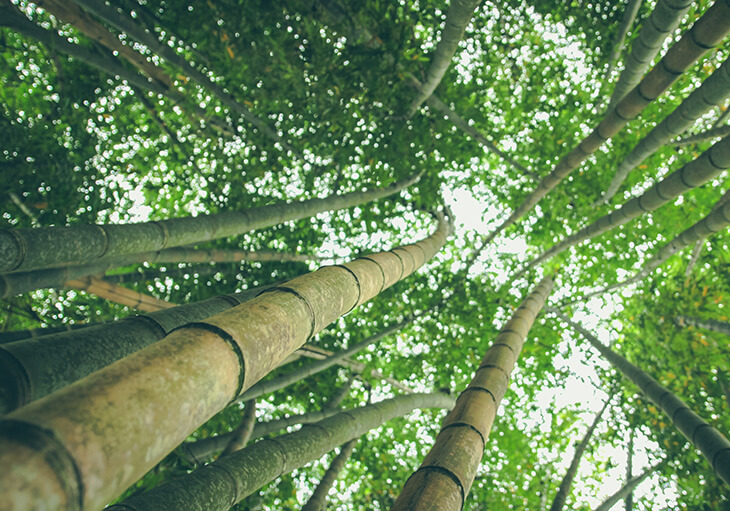
Bamboo Vs. Climate Change: Poor man’s timber or planet saving plant?
“We have to stop the devastating loss of our forests and end the role of humanity as nature’s conqueror, and instead become nature’s custodian.”
UK Prime Minister Boris Johnson speaking at COP26
COP26 and the forests of the world
Last month, the “most important climate conference of our lifetime” [i], the 26th Conference of Parties (COP26), came to an end. As the first real stress-test of the 2015 Paris Agreement to limit global warming to 2 degrees Celsius, the renewed commitments to a sustainable future made in the halls of Glasgow’s SEC will be sure to shape the global response to the climate emergency.
One landmark outcome was the World Leaders’ commitment to end deforestation by 2030, with 141 countries signing up (most notably, Brazil). The signatories cover 90% of the earth’s forests and include key players in global pollution – the United States, the European Union, and China – and a pledge of £14 billion[ii] to kickstart the “transformative further action” [iii] required.
The benefits of bamboo’s rapid growth
Flying the bamboo flag at COP26 was INBAR (the International Bamboo and Rattan Organisation), promoting the material as an “available, scalable and natural” resource that presents “a common climate solution for many developing countries in the tropics and subtropics” [iv]. As a species of giant grass, bamboo’s lightspeed growth rate in the right conditions (1 metre in 24 hours![v]) is unmatched by any tree and so is its intake of carbon dioxide – releasing between 30%-35% more oxygen than an equivalent mass of trees [vi] [vii] . Without a unified body of research, further exploration is required to realise bamboo’s full potential to combat climate change; however, what is indisputable is summarised by INBAR: “the main advantage for mitigating climate change lies in [bamboo’s] fast biomass generation and renewability”[viii].
Way back in 2014 the World Resources Institute wrote, “In the world of forestry, bamboo doesn’t always get the credit it deserves”[ix]. The tide may now finally be changing, as bamboo shifts from being the ‘poor man’s timber’ to ‘green steel’ and more awaken to its sustainable properties. Unlike chopping down trees, harvesting bamboo doesn’t spell the end for the plant. Quite the opposite in fact. Through selective harvesting of mature poles, the plant can regenerate for harvesting in approximately 5 years. Bamboo’s rhizomatic root system also becomes a carbon sink. Score 10 points for bamboo.

Global organisations becoming afforestation champions
The Swiss multinational food giant, Nestlé, presents a fantastic case study when it comes to championing reforestation with bamboo. Centred around their suppliers in the Philippines, a 3-year project is underway to plant 3.5 million native bamboo clumps and trees. This is an important step towards two of the organisation’s sustainability goals – the planting of 200 million trees by 2030 and reaching net zero by 2050.
With Nestlé valued at $347.9 billion [x], I like this example because it shows how global organisations can give back to the environment and be a living, breathing embodiment of their values. Nestlé’s whole approach is to become a “force for good”[xi] and this means looking beyond profits.
Other global companies are beginning to do their part with 1t.org’s corporate alliance bringing together brands like Unilever, AstraZeneca and HP to plant 1 trillion trees by 2030. BrewDog is another fantastic example of an organisation taking initiative to use afforestation to offset carbon. “There are no non radical solutions left,” [xii] writes James Watt, BrewDog CEO, as he takes the stance, “Our carbon is our problem, so we’re going to fix it ourselves”[xiii]. In 2020, BrewDog purchased a 9308-acre plot in the Scottish Highlands to begin the largest reforestation project in the UK.
You could say change is in the air!
Playing a part
“There is no pathway to a net-zero world without protecting and restoring nature”[xiv], writes INBAR, and while big companies can make big changes, we can also make small changes which nonetheless add up. Using bamboo as a long-term solution for garden, construction and interior design material requirements ensures that the carbon locked in the bamboo wood remains sequestered and the demand is reduced for the unsustainable materials driving over-exploitation of forests. For us at UK Bamboo, we work with suppliers that manage their bamboo forests in a sustainable way and have visited the Chinese forests to see this in action. Our bamboo boards and veneers are FSC-certified, as well as the bamboo tiles popular with interior designers. We are also exploring investing in bamboo manufacturing options to reduce our carbon footprint and help create employment at our supplier locations.
Research could unlock bamboo’s potential to combat climate change
According to Kew Gardens, there are 1642 species of bamboo, each with “remarkably difference characteristics”[xv]. Because of the sheer volume of bamboo species spanning the globe and climates, there are discoveries yet to be made. As a species of giant grass, it lies outside many of the established discussions on forestry (bamboo boards can be FSC certified, but not bamboo poles currently). Unfortunately, the pledge to end deforestation by 2030 made by world leaders at COP26 is not mandatory or enforceable, but there’s power in the start. As demonstrated by Nestlé, companies can take action too instead of leaving afforestation up to governments.
In the words of US President, Joe Biden, at COP26, “All we need to do is summon the will and do what we know is right. We can do this”[xvi]. Bamboo is part of the solution, and we are proud to work with this fantastic material.

References
[i] Law.com | “‘Possibly the Most Important Climate Conference of Our Lifetime’: Law Firms Out In Force For COP26”
[ii] BBC | “COP26 World leaders promise to end deforestation by 2030”
[iii] COP26 | “Glasgow Leaders’ Declaration on Forests and Land Use
[iv] INBAR | “Promoting low-carbon bamboo products at COP26”
[v] Royal Botanic Gardens Kew | “Thing you should know about Bamboo”
[vi] Bamboo Botanicals | “Interesting Bamboo Facts”
[vii] Business World | “Bamboo given major role in DENR reforestation plan”
[viii] INBAR | Working Paper No.65: “The Climate Change Challenge and Bamboo: Mitigation and Adaptation”
[ix] World Resources Institute | “Bamboo: The Secret Weapon in Forest and Landscape Restoration?”
[x] Investopedia | “6 Companies Owned (and 1 Major Licensing Deal) by Nestlé”
[xii] BrewDog | “The Lost Forest”
[xiii] BrewDog | “BrewDog is now carbon negative”
[xiv] INBAR | “INBAR Statement at the UN Climate Conference COP26”
[xv] Royal Botanic Gardens Kew | “Putting bamboo and rattan on the map”
[xvi] BBC | “COP26 World leaders promise to end deforestation by 2030”
